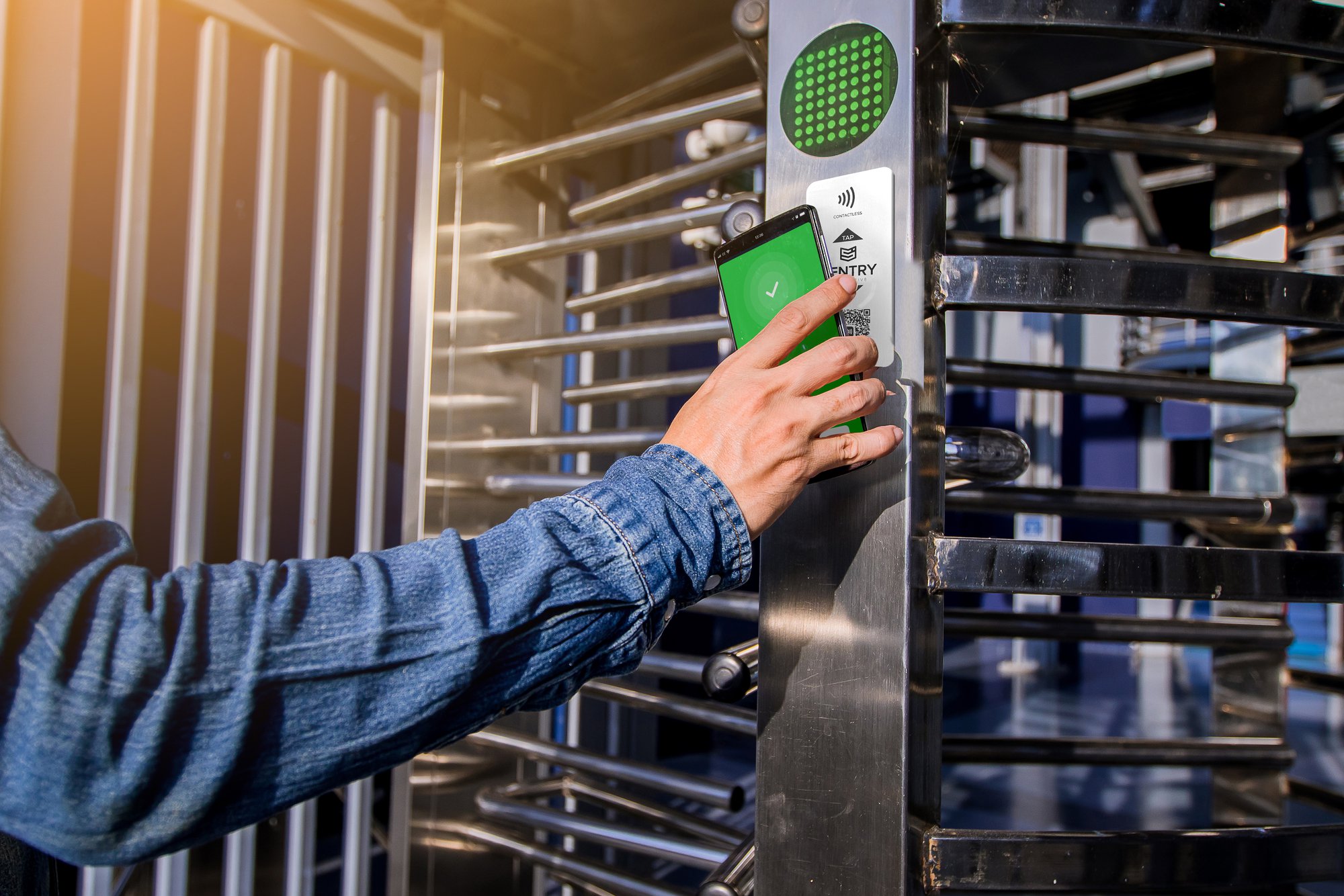New technologies are making our lives simpler, faster, and safer. Near-field communication (NFC) is no different. From fast and secure payments to mobile access control and data sharing, the technology is already an integrated part of our lives. But, what is NFC, and how can it improve access control in your facility?
Let’s explore how near-field communication works, including the ways it boosts security and reduces access control costs. We’ll also help you make an informed decision about whether NFC is the best technology to use for your mobile access control needs.
What Is NFC?
Commonly used in mobile phones, wearables, tablets, and card readers, near-field communication enables secure, short-range communication between devices. The wireless connectivity technology allows enabled devices to transfer information when in close proximity—generally no more than 1.57 inches (4 cm).

NFC technology developed largely to facilitate contactless payments, but now has various applications, enabling secure data exchanges and transactions of all sorts. Think of communication between public transport kiosks, digital wallets like Apple Pay, smartphones, smartwatches, ticket scanners, and even mobile access control systems.
Sentry Interactive, for example, offers an NFC-integrated, cloud-based access control solution to provide fast, reliable, and secure keyless mobile building access and visitor management. In addition, data insights enable you to see access patterns, when and how tenants use the building, and real-time building occupancy levels.
Understanding How NFC Works
Think of NFC in relation to Bluetooth technology. Both technologies are wireless data transfer mechanisms; however, they’re not exactly the same. NFC technology is more secure and features lower battery consumption, making it more suitable for financial transactions and building access—both common targets for security breaches.
NFC traditionally requires at least one transmitting or initiating device—such as a tag, card or fob—and a receiving device. Since NFC technology uses an alternating magnetic field, no energy emits in the form of radio waves. This prevents interference from other radio communications operating at the same frequency.
Sentry Mobile Access takes an innovative approach to conventional mobile access—now, the user’s phone acts as the reader. Sentry Access enables the smartphone’s inherent NFC capabilities, pairing it with a wireless NFC door tile. Said tile integrates with Sentry Access cloud infrastructure to provide frictionless and secure entry; after an authentication check, the door will unlock for permitted users.
Mobile Access Control as a Service (MACaaS) also provides secure data storage, maintaining a record of historical access data. Protected with enhanced military-grade encryption, multi-factor authentication, and permission-based hierarchical security, Sentry’s access control system security is without peer. All data complies with the UK DPA 2018/GDPR and any additional contractual clauses for regions outside the UK/EEA. Extra security levels like GPS Geofencing and IP restriction further enable tight privacy control.
Sentry Mobile Access’ suite of features pairs with the inherent security features of NFC-enabled smartphones for even more robust security. Near-field communication combined with biometric authentication creates a multi-factor access security system well beyond anything a standard Bluetooth system can provide.
The Communication Process Unveiled
One key benefit of NFC is that it’s easy to use. As mentioned, most smartphones have inherent NFC capabilities—so authorized users can unlock doors with an NFC door access app, which serves as their digital key. The user holds their mobile credential hardware up to the reader; then the reader receives and processes data to verify NFC tag credentials in one of two ways:
- If the device doesn’t have its own power source, such as a fob, it’s passive. This means the data transfer depends on power generated by the access control reader to communicate the encoded data.
- Active NFC devices, on the other hand, can send their own radio waves and streams of data because they’re battery-powered. This is where Sentry’s unparalleled technology shines through, as the data is sent directly to the cloud from the user’s phone and stored securely.
As the door reader receives the information from the NFC device, an access control panel matches the information to its database. If the data corresponds, the control panel activates the electronic lock to disengage and unlock, allowing the user access.

Advantages of NFC and Its Evolving Role in Access Control
Besides fitting in with our convenient, tech-savvy way of living, what is NFC really beneficial for? The advantages of NFC span much further than just convenience.

The keyless entry technology also improves safety and reduces business expenses. Let’s unpack some additional benefits:
Reduced Waste and Costs
Because there’s no need for physical access cards and printed tickets for check-ins, NFC technology is eco-friendly and reduces waste. In addition, NFC access removes the need for costly security system installation and maintenance if you integrate Sentry Mobile Access with your existing access controller/ access control panel.
Improved Operational Efficiency
A cloud server enables security managers to grant, disable, and revoke access remotely, ensuring the central management of permissions from any location. What’s more, organizations with multiple locations can easily manage NFC mobile access control for all buildings at once through ‘a single pane of glass’ application.
Personalization and Flexibility
You can provide personalized access rights based on a user’s role, location, and time. Certain staff members can even be granted access to certain areas, and guest NFC mobile access can be limited to only their appointment time.
Integration and Scalability
Expanding access is effortless since users simply download an app. In addition, the same NFC-enabled device that’s used for NFC mobile access control can also be used for secure printing and cashless contactless food purchasing at canteens.
Real-Time Monitoring
Remote access control systems offer data insights to see how and when tenants use the building. You can see entry and exit volumes, identify trends, and verify building occupancy levels. This data, captured via NFC mobile entry, helps managers optimize space and energy utilization.
Improved Security
NFC mobile access improves security by eliminating the chance of lost or stolen access cards. In the case of a lost mobile phone, administrators can deactivate credentials remotely.
Effortless User, Visitor, and Building Management
By integrating with a commercial property management system, you can automatically update when an employee leaves or joins the company. Tenants can use their NFC-enabled mobile phone–based access control system to grant and revoke access to guests at any time, including clients, deliveries, friends, and family.
NFC Applications Beyond Access Control
NFC technology holds limitless potential for future innovations, beyond just access control and contactless or mobile payments. Let’s briefly consider some additional uses, such as:
- Unlocking rental scooters and car doors
- Ticketing and entrance at concerts and other events
- Automatic WiFi connectivity setup by tapping a mobile device to a router
- Smartphone connection to a radiator to configure schedule and temperature settings
- Smartphone or tablet connections to industrial equipment to access detailed control panels
- Electronic voting across all levels—college, municipal, state, federal, and so on
- Transferring fitness and sleep tracking data from a wristband to a smartphone
- Medical record keeping for patients
- Inventory tracking in logistics and supply sectors
- Automated hotel check-ins and room access keys
- Automated airline check-in and boarding access
- Controlled road access at unmanned toll sites for governments and private road owners
NFC tags can also be configured for home automation to set alarms, open doors, switch lights on or off, and activate home cooling and heating.
Unlock the Potential of NFC With Sentry Mobile Access
NFC mobile access control systems are transforming building access management and enhancing security. They offer numerous advantages, such as centralized management, optimized traffic flows, and real-time monitoring. In addition, they offer an improved experience for both employees and their guests.
A solution like Sentry Mobile Access can integrate into existing access control systems to provide cloud-based access control that doesn’t require new hardware.
Discover the range of innovative features and capabilities available with Sentry Mobile Access to boost facilities management, improve security, and reduce costs. Contact us today to discuss the solution for your unique property and business needs.


